Adi Hütter has enjoyed an excellent start to life in the dugout at Stade Louis-II, guiding AS Monaco to three wins and one draw from their first four games of the season, putting them two points clear of second-placed PSG.
Indeed, it’s still very early days and far too early to make any big conclusive statements with regard to the 53-year-old and his Monaco outfit. However, after spending a season out of the game following his May 2022 Borussia Mönchengladbach departure, it’s clear Hütter is reinvigorated, with this motivation manifesting itself in a Monaco side that’s been operating on another level to their Ligue 1 competition, thus far in 2023/24.
Monaco are currently the top scorers in France’s top flight, having netted 13 times in their opening four games. This tactical analysis and team-focused scout report will focus primarily on how Hütter has engineered such a potent attack in the principality. Still, this analysis will focus on the team’s strategy and tactics both in and out of possession, with both sides of the game playing a pivotal role in Monaco’s threatening attack.
Build-up and ball progression
Firstly, we’ll take a look at how Hütter’s side approaches the early possession phases of build-up and, primarily, ball progression.
Monaco line up in a base 3-4-2-1 shape this season, and from the build-up, we typically see one centre-back step slightly wider while the other two get on either side of the goalkeeper. As they progress into the ball progression phase shortly after this, one centre-back moves more centrally while the other two take up fairly wide positions on either side of him.
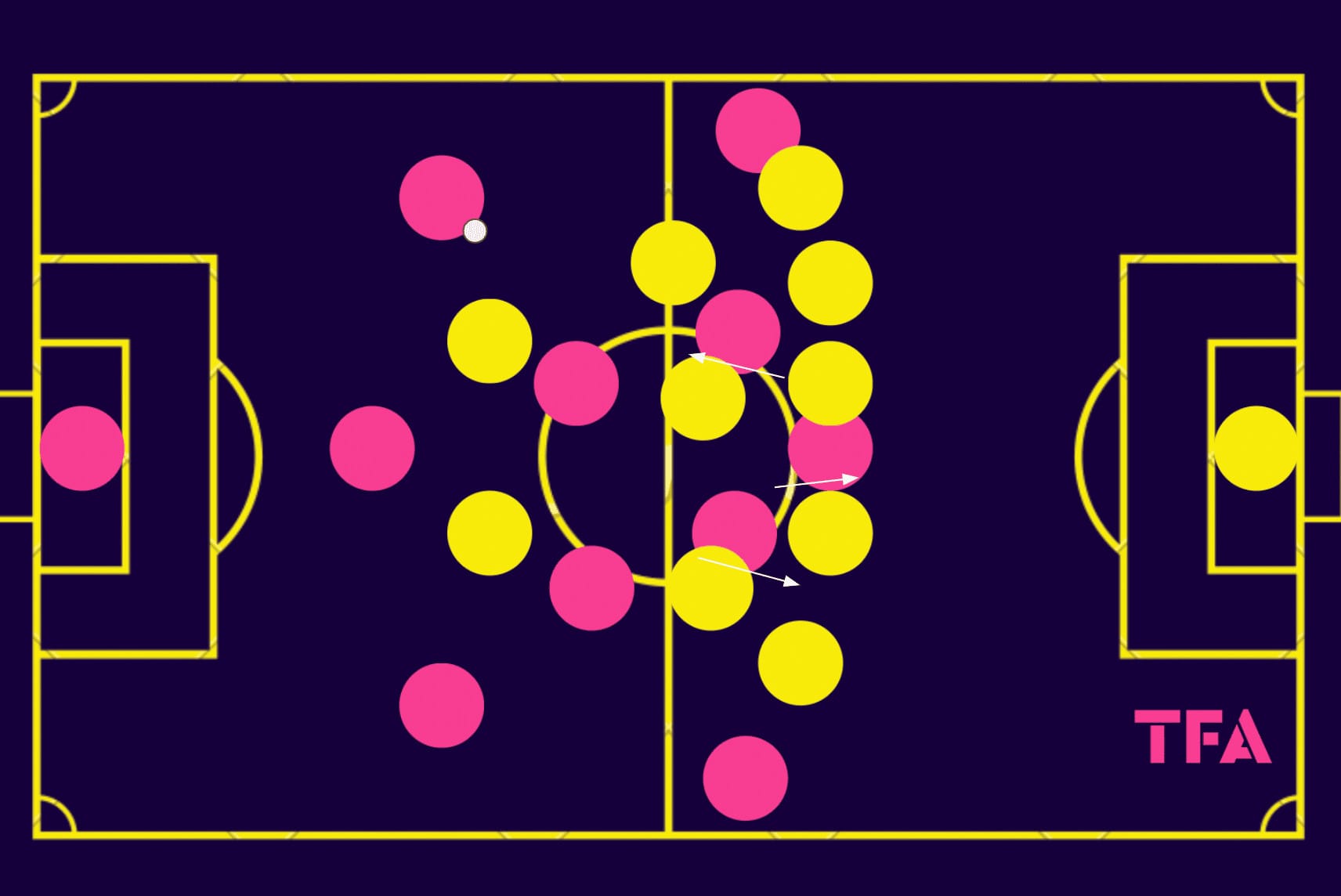
This example in figure 1 is taken from a certain point in their Ligue 1 clash with Strasbourg earlier this season. With Monaco represented by the pink dots, attacking from left to right, we see how they essentially form a 3-2-4-1 shape in the progression phase, with the wing-backs positioning themselves high and wide on either side of the pitch, providing the offensive width for their side.
Monaco have been excellent at feeding their three forwards while progressing upfield this term. The wide centre-backs enjoy good progressive passing angles for the more advanced attackers to move about and try to give options to; meanwhile, an immense amount of credit needs to be handed to the forwards for continuously making such deceptive and difficult-to-track movements that create space for themselves in these advanced areas.
It’s common to see the forward trio performing alternating movements in the progression phase — as one would position themselves right on the defenders’ shoulders or make a run in behind, another might drop in between the lines and try to receive to feet.
The specific players performing specific movements would change so as to keep defenders guessing and make their movements more challenging to prepare for and deal with, which has undoubtedly proven very tricky for Monaco’s opponents this season.
Thanks to the quality passing from the deeper players, such as the centre-backs and midfield duo — who also provide very useful shuttling runs to facilitate ball progression from the backline to the forward line along with the wing-backs — as well as this intelligent, deceptive movement from the forwards, Monaco have been able to carve through opponents in the progression phase this term, setting them up to bomb into the final third and generate goalscoring opportunities with great regularity.
This is a significant reason why they’ve enjoyed such a positive start to the 2023/24 campaign. Les Monégasques have played by far the most through passes (12.83 per 90) and smart passes 6.63 per 90) of any team in France’s top flight this season, which largely results from this ability to find their attackers in space high upfield.
This gives the likes of Aleksandr Golovin and Takumi Minamino a chance to receive, turn and split a defence open thanks to their off-the-ball movement and technical quality with the ball — and those players, in particular, have thrived in Hütter’s system so far this season.
Attackers’ movement in the final third
On reaching the final third and entering the chance creation phase, the movement from Monaco’s attackers has proven vital this term. In order to find freedom and space within the final third, their attackers need to capitalise on their teammates’ movement and, simultaneously, offer runs both to give passers options and drag defenders away to create space for another teammate to exploit potentially.
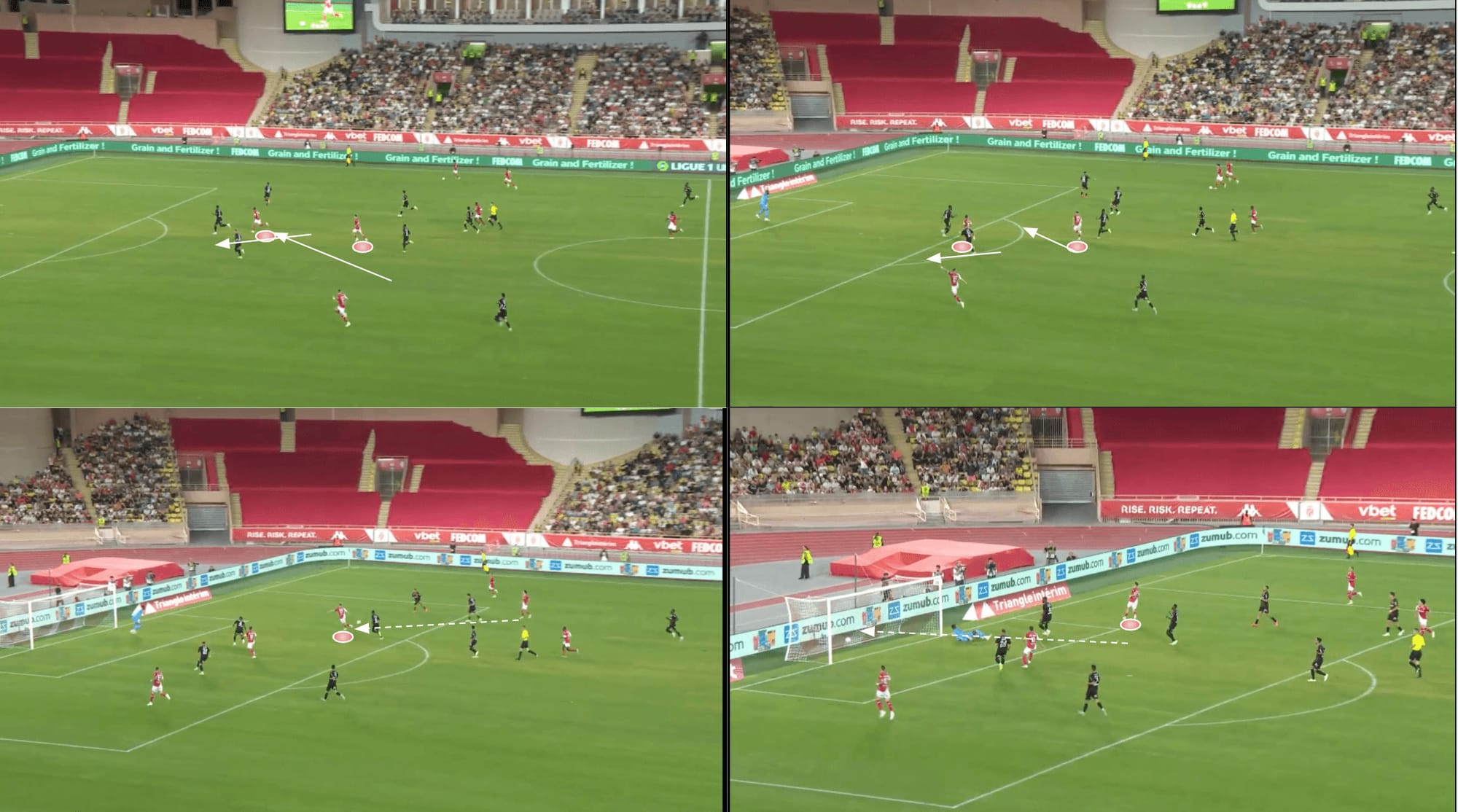
Take figure 2 as an example. Here, as Takumi Minamino carries the ball along the right wing, Wissam Ben Yedder makes a run across the face of goal as he makes his way into the box.
This drags Lens’ central centre-back away from their left centre-back, creating a big gap in the defensive line for Aleksandr Golovin to exploit with another run across the face of goal but in the opposite direction, towards the near post.
Minamino picks out Golovin in plenty of space inside the box, enabling the attacker to tuck the ball away at the near post, putting Les Monégasques up by two.
This is a perfect example of how Hütter wants his forwards to act — making unselfish runs, watching out for space their teammates create and capitalising on each other’s movement to create good passing options for the ball carrier.
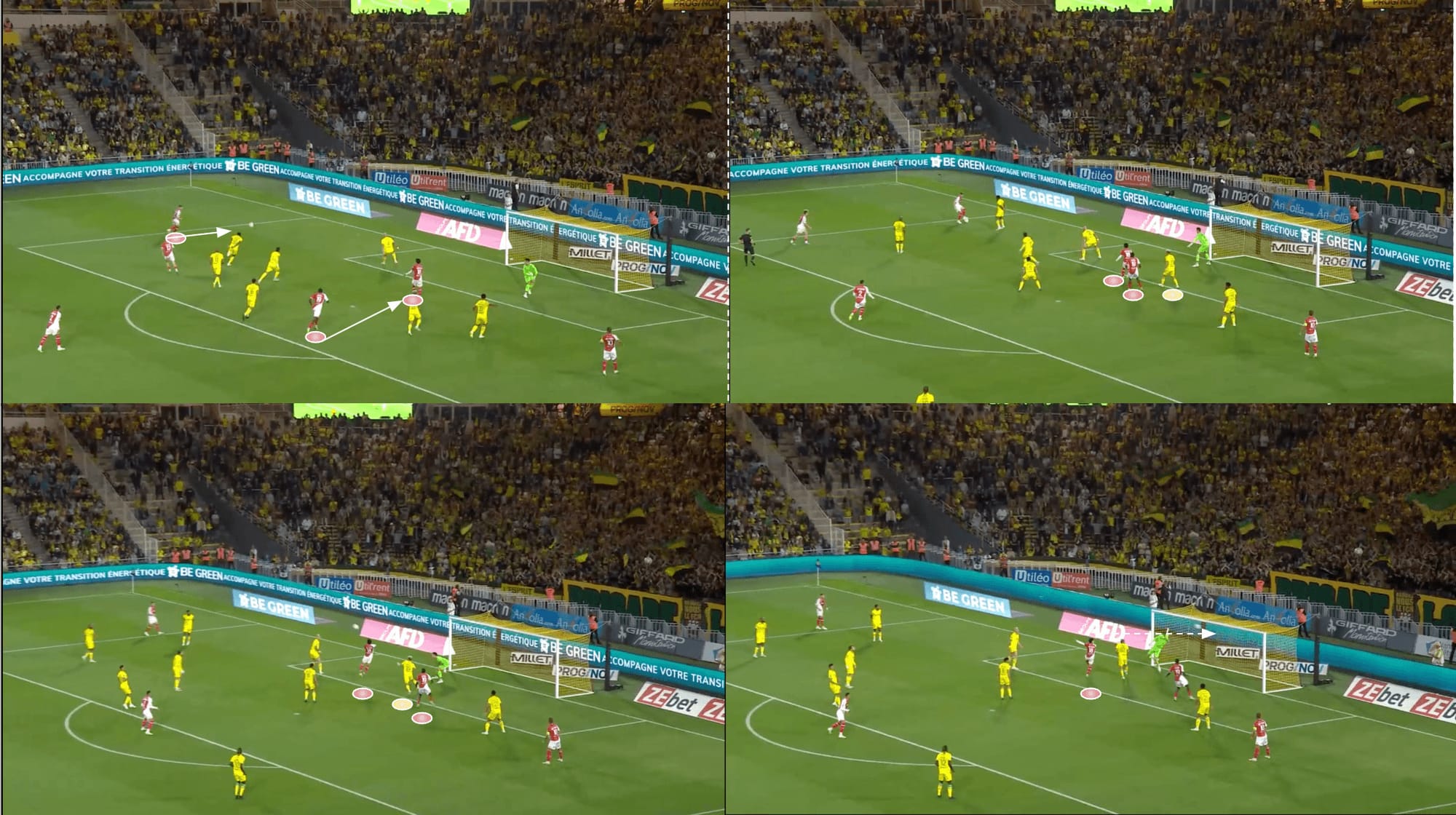
In another example, this time with the ball out wide in a crossing position, Youssouf Fofana moves into a precious spot from which to get a shot off, doubling up on the defender covering that zone.
As a result of the aerial threat Fofana poses, the defender opted to cover him, thus allowing Takumi Minamino to get a free header and put the ball away past the opposition’s goalkeeper.
Again, it’s unselfish movement and capitalising on teammates’ movement/positioning that creates this excellent opportunity and eventual goal for Hütter’s side.
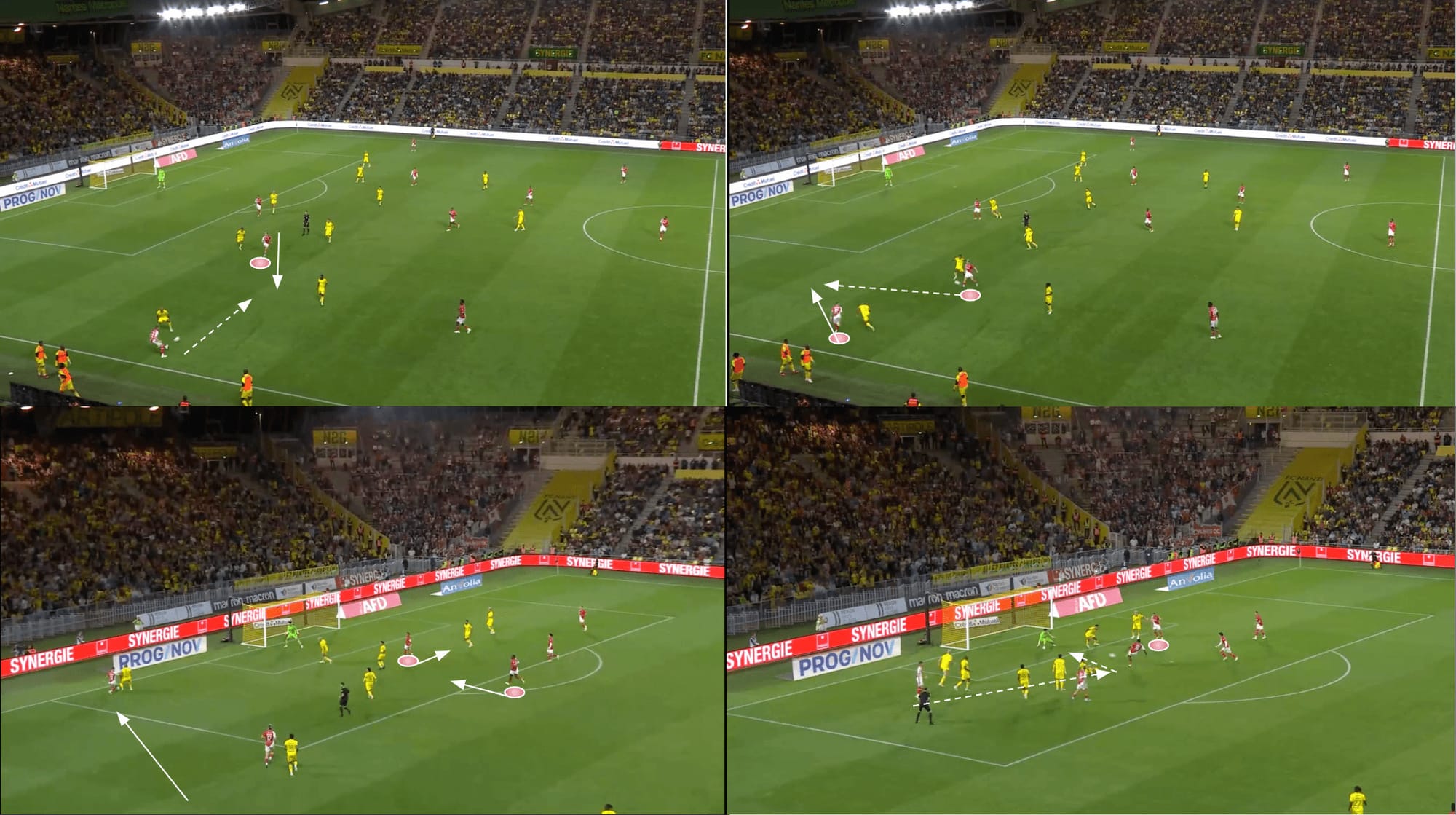
The 3-4-2-1 shape creates a natural five-player forward line with the wing-backs pushing up. Even if playing against a back-five, as Monaco were in this example versus Nantes, they can drag the opposition defenders into 1v1s and pull them around the pitch, helping them to find ways through their defensive block.
In this case, shown in figure 4, the left forward, Golovin, dropped off to give the left wing-back a decent half-space option to feet. The opposition’s right centre-back follows the attacker, creating space for the wing-back to target with his run in behind; Golovin picks out that run with a well-weighted through pass, setting up an excellent opportunity to cut the ball back.
Fofana enters the box via a deep run and manages to get a shot off from a very valuable location as a result of the centre-forward, Ben Yedder, dropping back and dragging the defender in that particular zone away from the deep runner’s path. The shot is deflected into Ben Yedder’s feet, and the prolific striker managed to put the ball away.
This was another goal Monaco scored largely due to intelligent movement and combination play in the final third, which Hütter has done well to foster and helped Les Monégasques make a habit of in 2023/24.
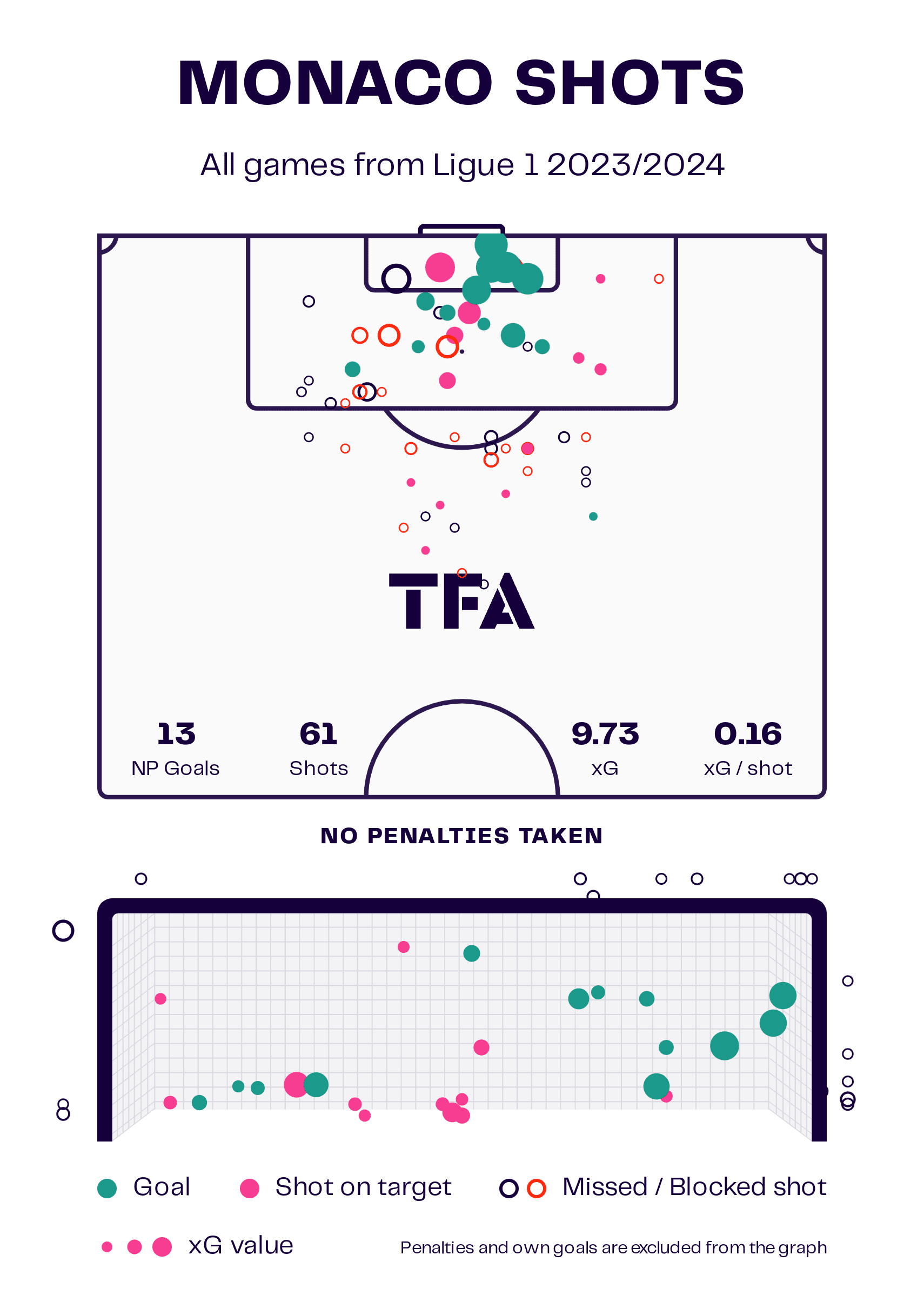
As figure 5 displays, Monaco have scored 13 non-penalty goals from 9.73 xG this term — the highest number of goals and third-best xG in Ligue 1 for 2023/24.
They’ve also generated the fifth-highest number of shots (13.49 per 90) and fourth-best shot accuracy rate (41%) while maintaining a highly respectable xG per shot of 0.16.
Their high goals tally and impressive shot locations have been achieved in large part due to the in-possession strategy and tactics we’ve analysed in this piece, but it’s not just their on-the-ball approach that’s led to their goalscoring success; their out-of-possession play has also played a vital role.
Out of possession
Of course, the main aim without the ball is always to prevent the opposition from scoring — this is the priority and what always springs to mind. Hütter’s done very well to prepare his side for this this season, helping Monaco concede just five goals in the league while conceding just 6.63 shots per 90 — the lowest in France’s top-flight.
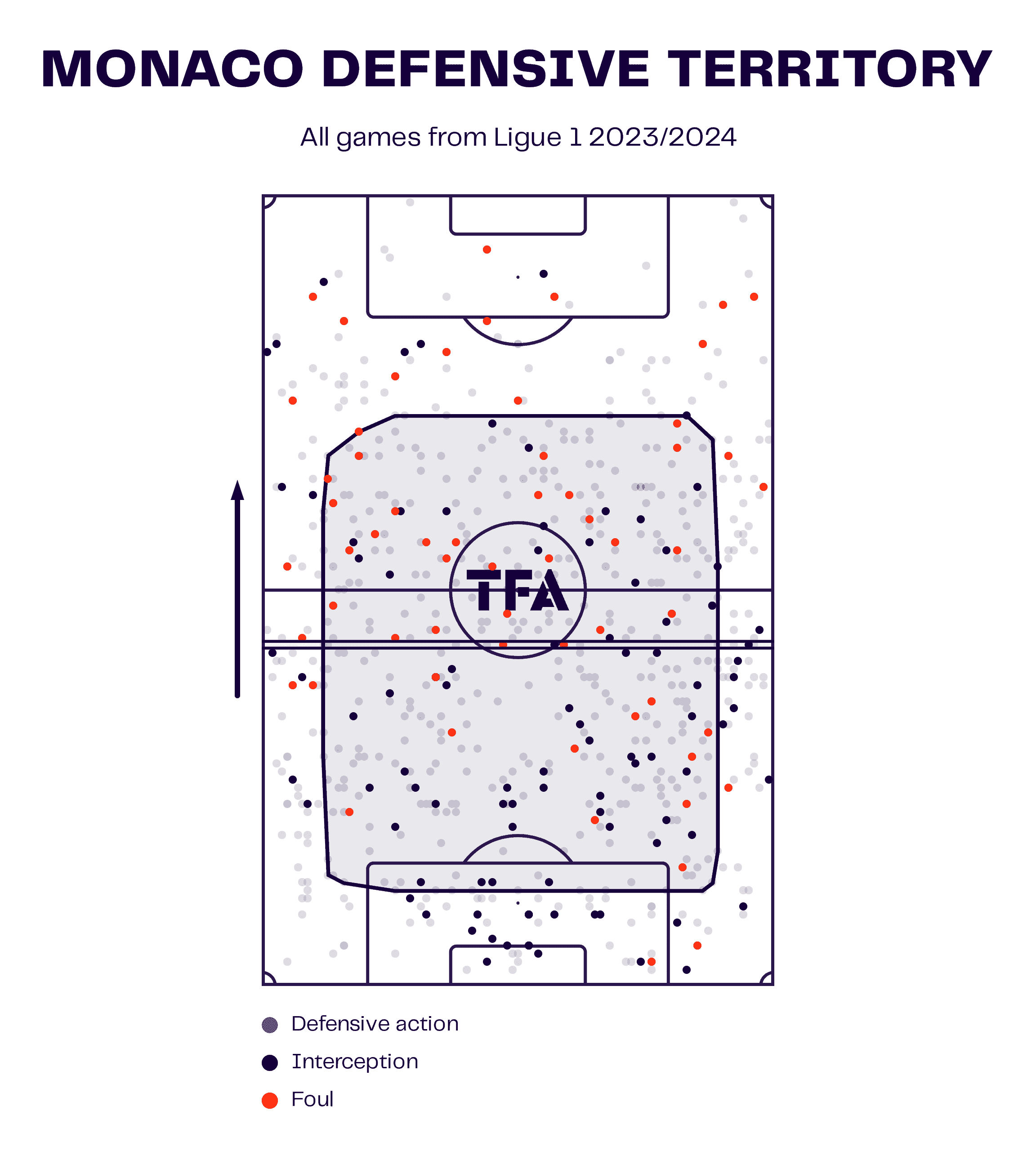
Figure 6 gives us an idea of how Hütter’s Monaco defend, with their average defensive territory marked out on the viz, along with the locations of all their defensive actions.
Additionally, we see Monaco’s average defensive line height marked out on this image — and it is quite high; this is indicative of how Hütter has set his side up to press the opposition quite aggressively from their build-up.
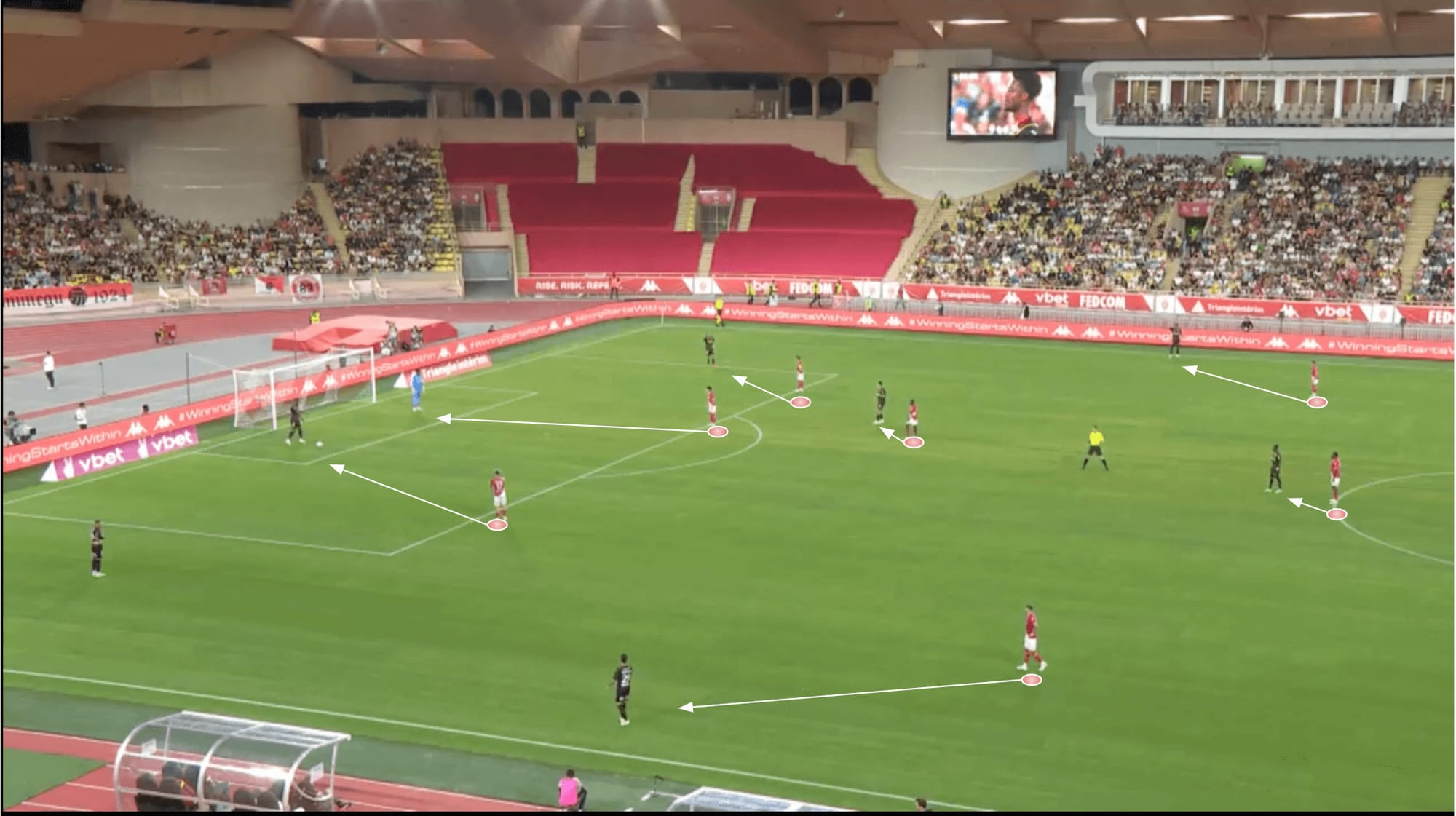
Here, we have a typical example of how Hütter’s Monaco set up in the high-block phase.
The three forwards sit right on the edge of the opposition’s box as they begin their play from the goal-kick.
At the same time, the wide forward on either side gets ready to pounce on the defender who receives while the other forwards prepare to jump up onto the near passing options and close the space around the receiver, limiting their passing options.
The wing-backs sit high, retaining access to their counterparts on the opposition side out wide, and the central midfielders essentially mark player-to-player, following the opposition’s midfielders around quite closely, which, in this particular instance, created a bit of a midfield diamond — this is purely a result of the midfielders’ man-marking instructions, however.
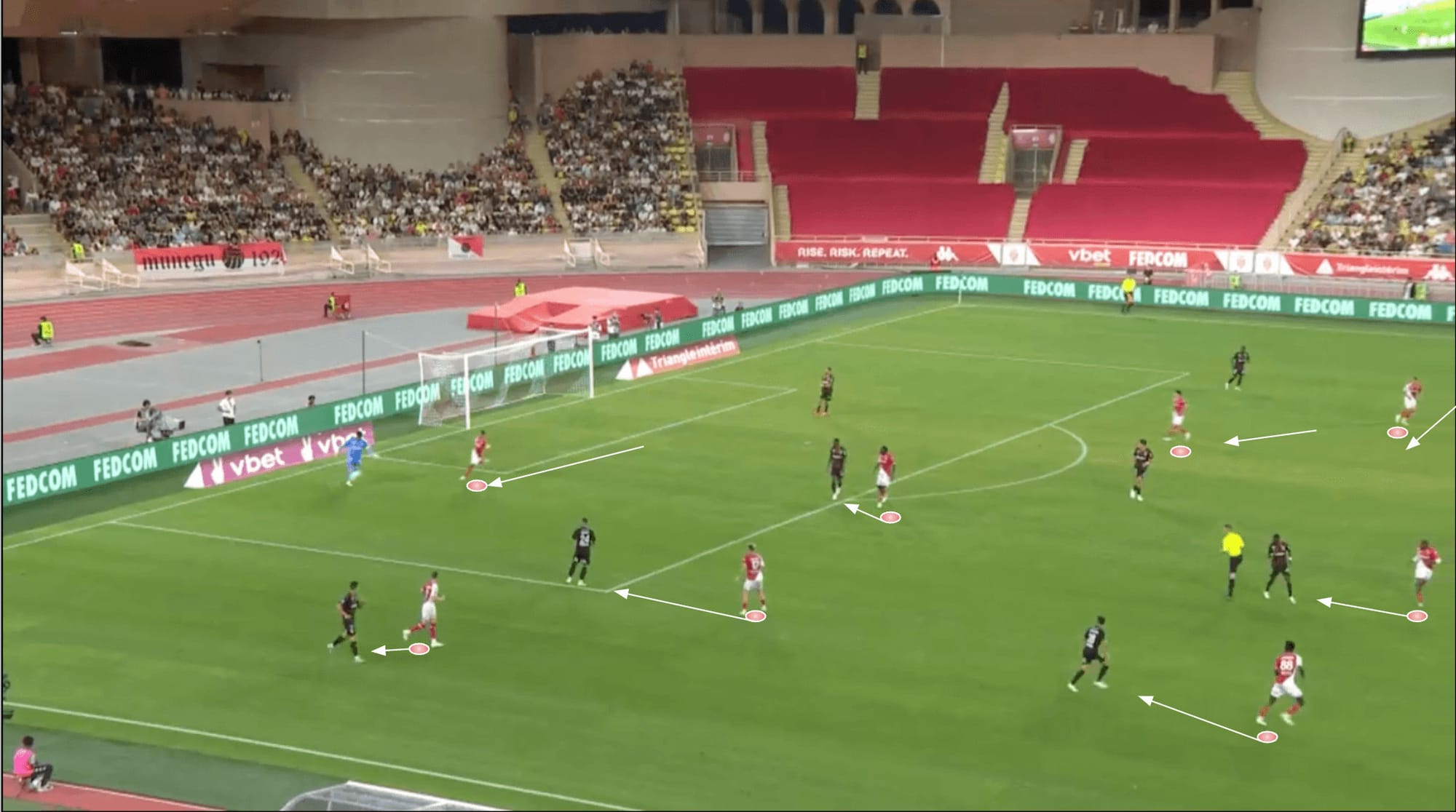
We see an example of a passage of play where things are slightly more advanced beyond the very beginning of the goal-kick in figure 8. We can see how the Monaco forward closes down the goalkeeper while keeping the centre-back in his cover shadow while his teammates perform their roles in cutting off the nearest passing options to make progression more difficult.
Monaco try to force the opposition to one side and make the pitch really small, ensuring the short passing options are not on. In this image, we can see eight Monaco players camped well inside the opposition’s half; all focused on restricting the opposition to this small zone in their bottom-right eighth of the pitch.
This strategy involves the ball-far wing-back coming quite narrow, as we see here, focusing on trying to force a turnover either by dispossessing the opponent high upfield and immediately generating a decent goalscoring opportunity or forcing the opposition long and winning the ball back deeper where Les Monégasques can restart their attack from the back.
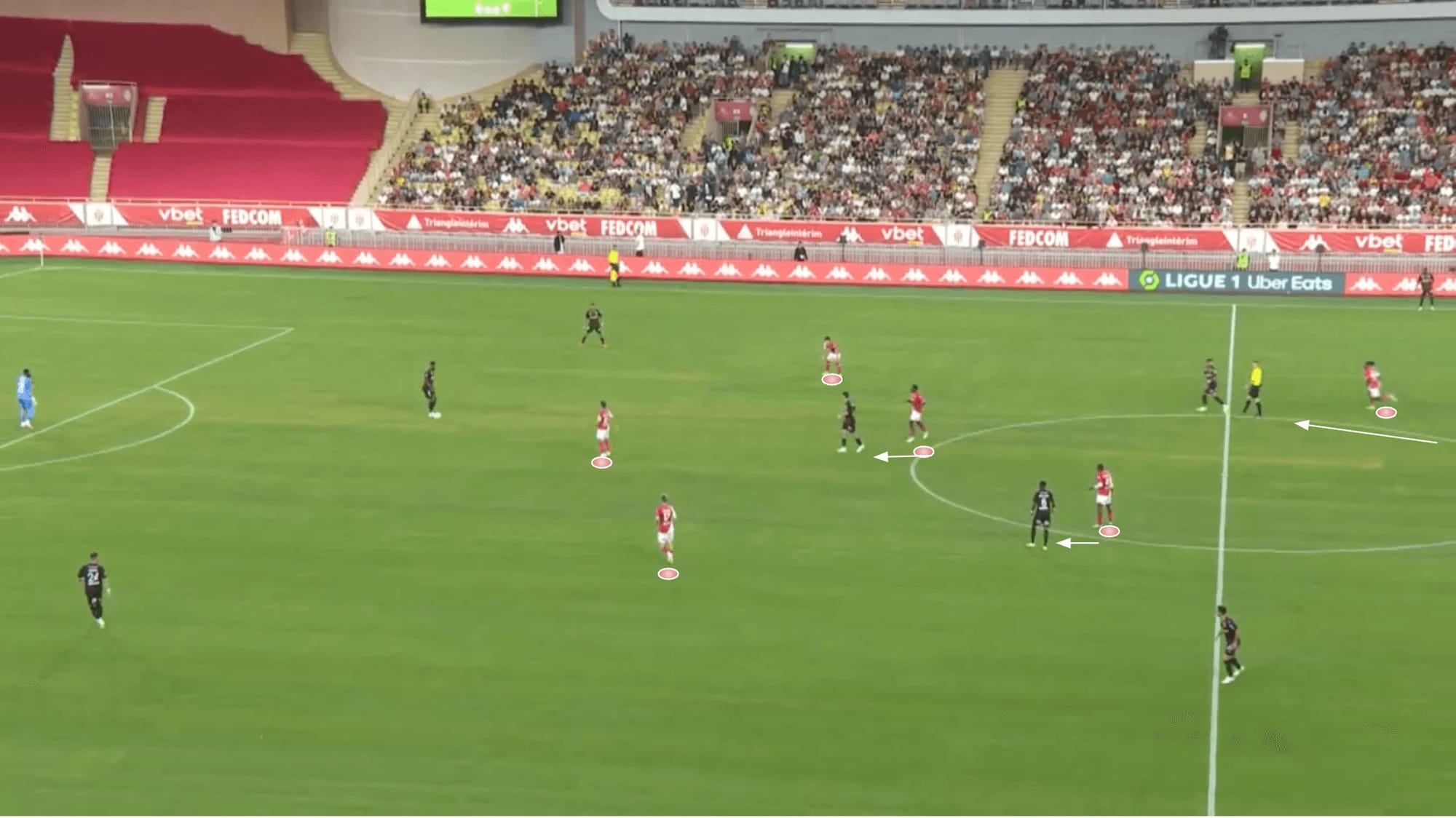
Figure 9, then, shows an example of Les Monégasques in the mid-block phase — slightly deeper than we’ve seen them in the previous examples. Again, the front three are prepared to pounce on a pass out to either wide centre-back while the central midfielders man-mark and the wing-backs take care of their opposite numbers (out of frame).
One potential weakness to Monaco’s defensive system is if a midfielder gets dragged high due to their man-marking instructions, an opposition player could drop into the midfield behind them and overload Hütter’s side in the centre of the park.
To deal with this, Monaco’s centre-backs have the license to push up into midfield, adding a third body into the centre and alleviating the pressure on the other two midfielders to keep an eye out for what’s going on behind them so much.
We can see this happening in figure 9, as the right centre-back makes a vital movement up into midfield from centre-back, keeping Monaco difficult to penetrate through the middle.
These defensive tactics have helped Monaco make their opponents’ lives very difficult, limit what they’ve done to Les Monégasques on the ball and help Hütter’s side dominate the possession, imposing their game on the opposition rather than the other way around.
Transitions
For our fourth and final section, we’re going to touch on how Hütter’s Monaco have performed in transitional phases. Again, we’d say this has been a strong point for Les Monégasques this term, which has been vital to their success going forward.
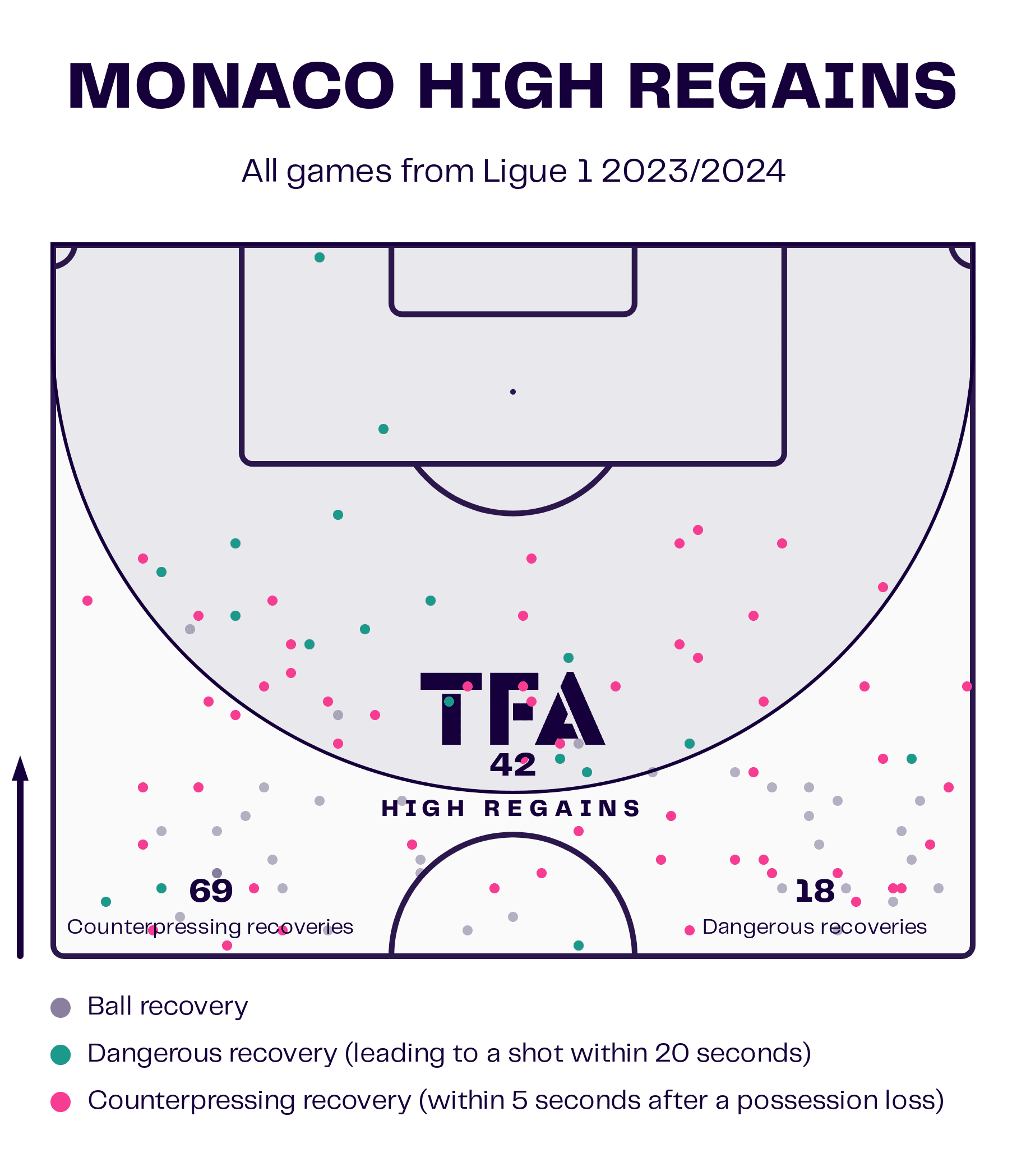
Firstly, as figure 10 displays, Monaco have made 42 high regains, 18 dangerous recoveries and an impressive 69 counterpressing recoveries in their first four Ligue 1 games of 2023/24.
Indeed, counterpressing has been a critical part of their game this term, and the players’ suitability for this style has been crucial to Hütter’s flying start. Very quickly, the team appears incredibly comfortable with what’s being asked of them in this regard, and it’s a very natural response for them to step forward and press in unison after a turnover.
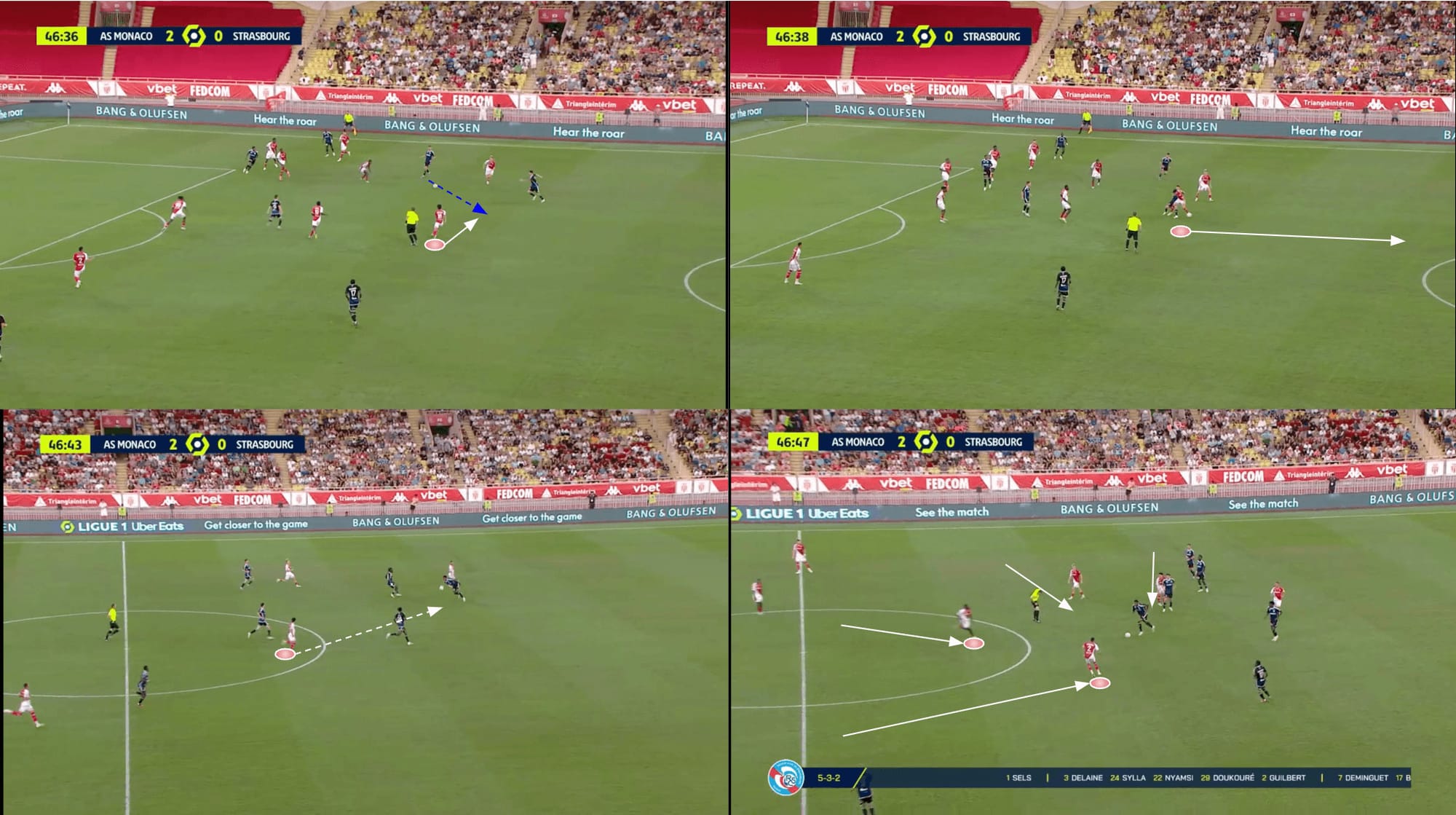
Figure 11 provides a great example of this. After Minamino — a great player to have for a counterpressing, transitional side like Hütter’s, who has thrived this term in France — regained possession in his half by reading the opponent’s pass well and pulling off a great interception, he beats a man (top-right corner). He carries the ball into the opponent’s half.
After the Japan international’s attempted through ball just inside the opponent’s half is intercepted, we see his teammates immediately jump into action; with no doubt in their mind about what the next step is, they jump up and surround the opposition’s ball carrier, attempting to quickly win possession back, giving the opponent no time to breathe, let alone think about their next move.
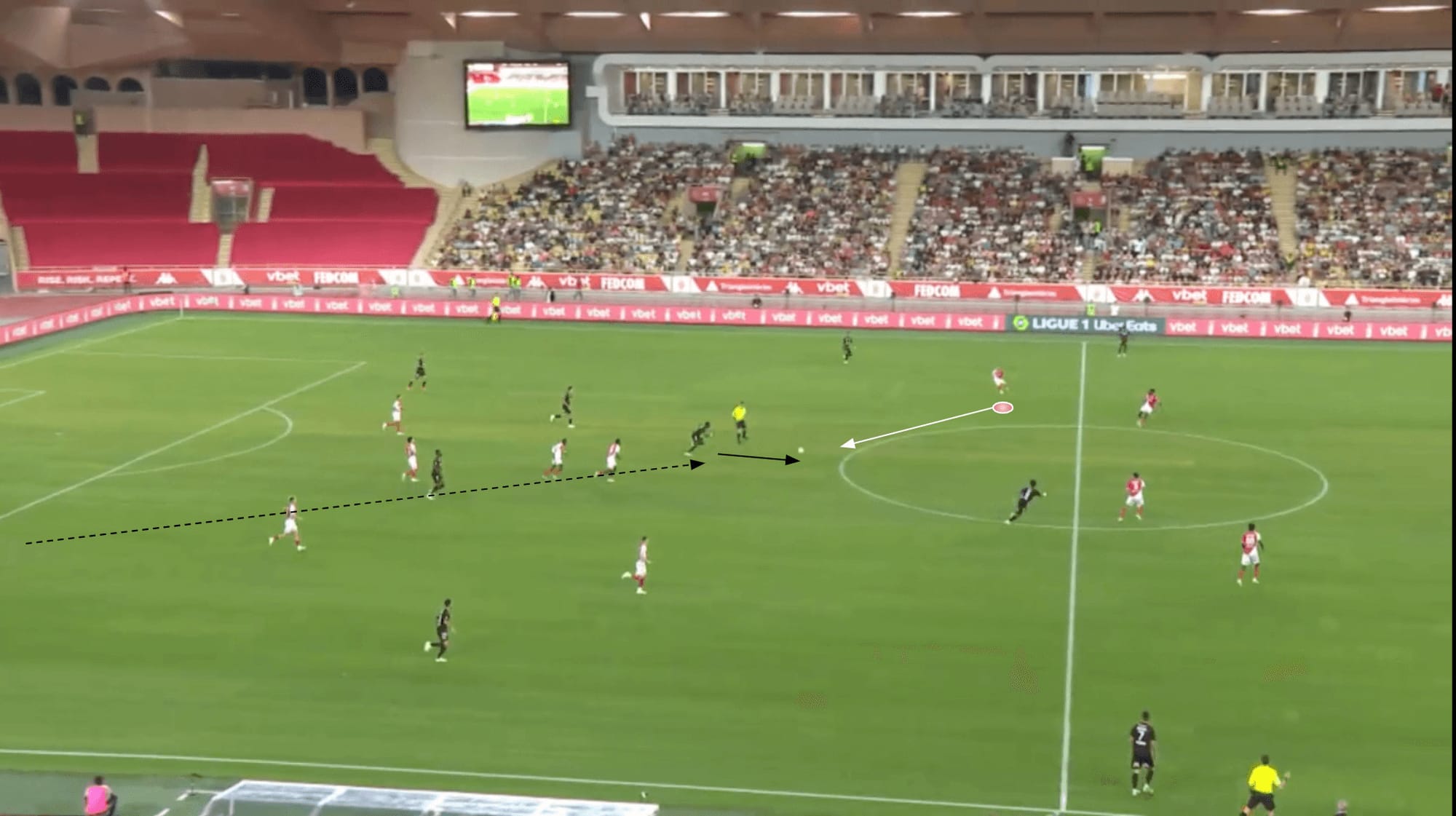
Indeed, another potential weakness here can be the space opening up behind those players who jump forward and in front of the backline. Once more, centre-backs have some freedom to move forward and help the midfield out in this instance — a benefit afforded to them by the three-centre-back system.
However, wing-backs will also move inside in such instances, as we see in figure 12, if they’ve got easier access to the central passing options. They won’t be as tied to the opposition’s wing-backs in transition compared to in the high-block/mid-block as we analysed previously, so it’s not uncommon to see them offering support more centrally in transition.
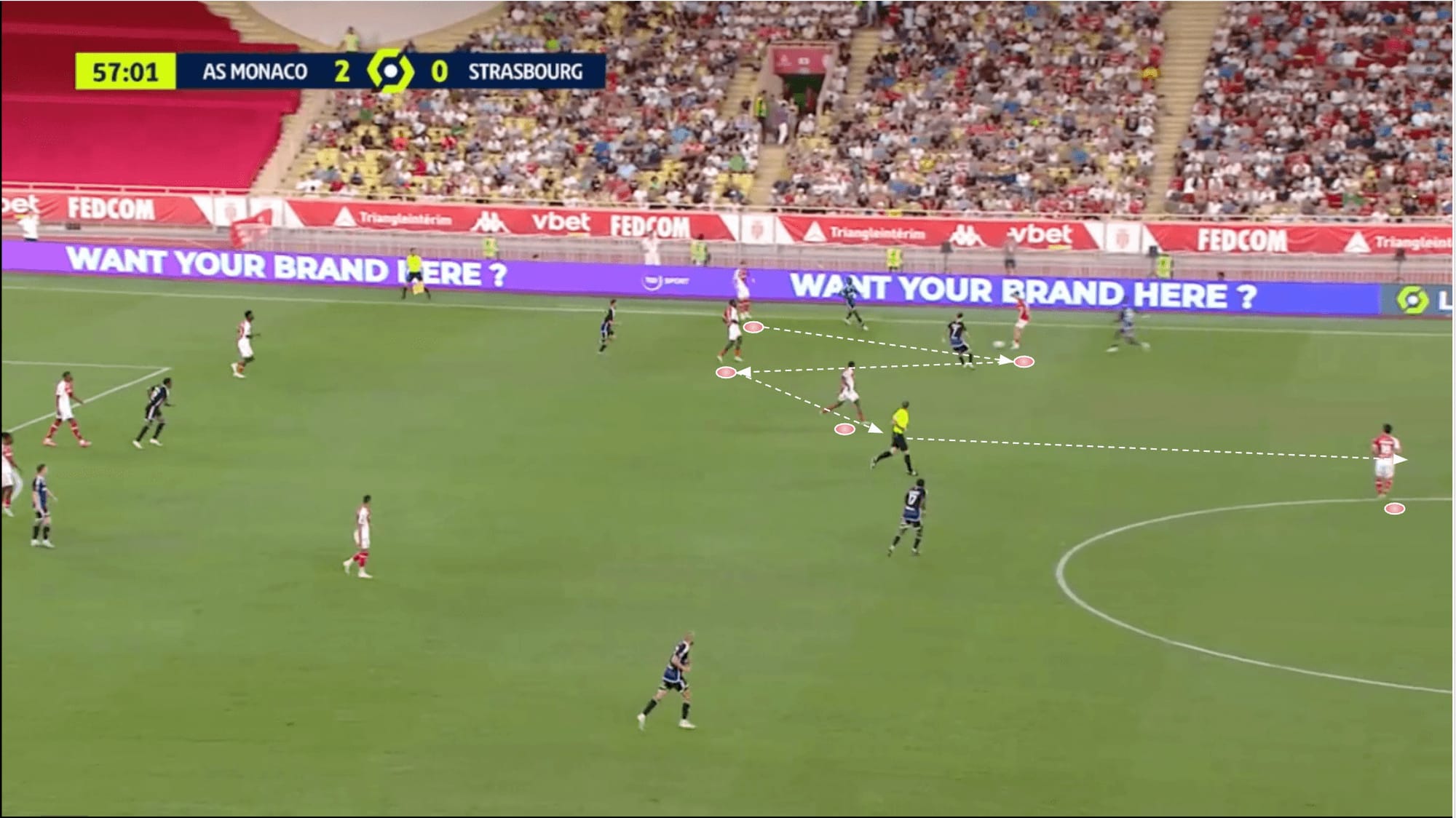
As a result of Monaco’s pressing approach that we analysed back in figure 8, where they attempt to box the opponent into one particular small zone, they often have lots of bodies positioned closely together after a turnover, meaning they have lots of quick passing options to help them carve through the opposition’s unsettled defence, as figure 13 displays.
They were well able to beat the opposition’s counterpress and send the ball forward into the final third quite quickly after winning the ball back — highlighting another benefit of their defensive organisation and how it can benefit Les Monégasques’ attacking play and not just their defence.
Conclusion
To conclude this tactical analysis, it’s clear Hütter has implemented some excellent ideas both in and out of possession that have clearly resulted in Monaco’s on-field success this term.
The Austrian coach has given Les Monégasques a very clear identity and way of playing that every player demonstrates excellent knowledge of and ability to execute well.
The good news for Monaco fans is that the team still hasn’t had a lot of time under Hütter, and the potential to grow from here under the 53-year-old is high!





Comments